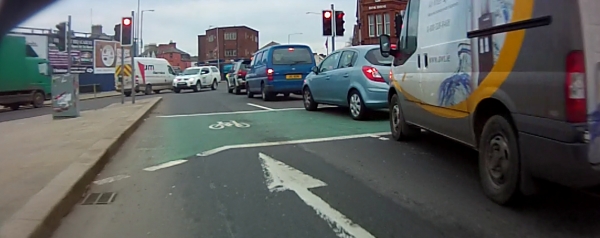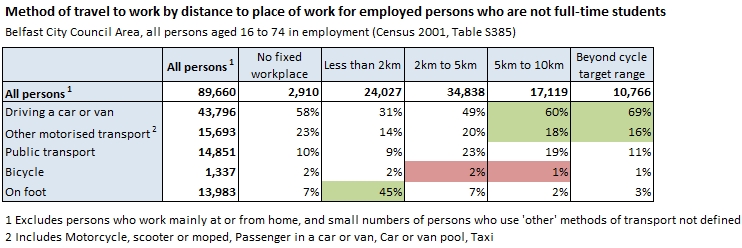During the recent hot spell in May, I launched a mighty Twitter rant about the dearth of cycle commuters in Belfast. I was fairly challenged on a number of assertions about Belfast’s population and commuter flows. Having subsequently had a little time to look over available data, there are some clear conclusions to be drawn about the possibilities of modal shift in Belfast – getting punters to give up car travel in favour of the humble bike.
My broad argument was that the Belfast City Council Area workforce and places of employment are closely aligned, that the Council area itself is quite small, and that many short journeys to work could easily be switched from car to bike. Not only are there benefits to long-term health outcomes, more money in people’s pockets through spending less on cars and fuel, reduced congestion and environmental and road damage, but there is one really big attraction for many commuter cyclists – journeys on bike are faster than by car during Belfast rush hour.
I argued that a high proportion of workplace journeys within Belfast will be at most 3-5 miles. This is based on the shape of the Belfast District Council Area and the concentration of jobs within the City Centre.
Gathering real evidence
I start with a health warning – this is not an academic exercise, and I appreciate there are complexities beyond the bare figures which need to be accounted for. However there is hopefully some interesting data here, freely available for anyone to check. NISRA publishes Census data in Northern Ireland, and the last dataset from 2001 provides a detailed look at population and workforce dynamics in Belfast. A little spreadsheet work, and we have a starting point. Happy to be corrected on any errors, and for comments on the analysis.
Belfast as a self-contained economic unit
In the 2001 Census, figures show that of jobs based in the Belfast City Council Area, 45% of employees lived within Belfast and 55% travelled from outside. This ran slightly counter to my assertion, showing that people working in Belfast are not exclusively living in Belfast. Crucially though, just under 100,000 Belfast City Council residents aged 16 to 74 were in employment in 2001, and around 75% of these employees travel to a workplace also within the Belfast City Council Area. So a high proportion of travel to work journeys by people living in Belfast are made within the council boundaries.
Belfast as a small city
Tracing the longest journeys within the Belfast City Council Area is relatively simple. Three journeys at the extremes of the map are detailed, with the total distance travelled on road:
Mill Avenue Ligoniel to Stormont Gates 7.4 miles
Grays Lane, Antrim Road to Malone Golf Club 7.8 miles
Bell Steele Road to Old Hollywood Road 9.2 miles
I suggest these are not typical journeys within the labour market, with a high proportion of Belfast workers travelling to the City Centre, or likely to work within the immediate vicinity of their residence, or be travelling to employment centres outside of the Council area, such as industrial estates or orbital population centres. Later data bears out the nature of workplace journeys within Belfast.
The vast majority of the resident population lies within a 3-4 mile radius of the City Hall. One of the farthest examples shown above, Malone Golf Club, is still just 5 miles from Belfast City Hall, and even it benefits from the traffic-free option of the Lagan Towpath.
Belfast’s car addiction for short journeys
What drives my argument are journeys within Belfast at a distance where the bicycle is a both a viable and attractive alternative to motorised transport. The last Census in 2001 provides good data on travel to work flows in the Belfast City Council Area, and we are able to draw some broad conclusions from the data.
Of Belfast residents in employment, 26% live within 2km of their workplace. At a generously slow average speed of 10mph, this is 8 minutes on a bike. 37% of residents live between 2km to 5km from work, at most 19 minutes by bike, and 18% are between 5km to 10km, or 38 minutes by bike. Most commuter cyclists would suggest 15mph average is not uncommon, even in rush hour, which vastly improves on these times and easily outperforms both private car travel and public transport for the same door-to-door journey. (I heartily apologise for my imperial/metric mash-up!)
Pinpointing cycling policy failure in Belfast
Census data allows us to get a closer look at the methods used for travelling to work over defined distances. The table below shows residents of the Belfast City Council Area, and their preferred main method of travel to work within the ranges where cycle modal shift is realistic. Bicycle commuting reaches no more than 2% in any range, matching more recent DRD Travel surveys which estimate around 3% of all journeys made in Belfast are by bike (not exclusive to commuting).
A staggering 45% of journeys to work under 2km (1.6 miles) are made by motorised transport, fertile ground for a shift to cycling and walking. In the 2km to 5km range, a sharp drop-off in walking is not replaced by cycling as could be expected – instead we see nearly 70% of journeys by motorised transport. This, along with a drop to 1% cycle usage in the 5km to 10km range, perfectly pinpoints the failure of current policy. If investment was balanced fairly between pedestrians, cyclists and motorists, we might reasonably expect to see higher levels of cycling in the 2km to 10km range.
It should be noted these distances are ‘as the crow flies’ between the centres of the postcodes of home residence and workplaces, therefore journeys will vary slightly in length according to the actual route by road.
The results from the 2011 Census will be keenly anticipated, as modal shift may naturally be occurring at a low level. However the challenge for policy makers and planners is evident from this small piece of data.
Belfast cyclists speeding past policy makers
Tonight (7th June 2012) happened to be the wettest evening rush hour of the year so far (go June!), and I chose to drive the car to work today. My homeward journey was 2.75 miles in 32 minutes (including a 5 minute walk to the car), or a total average speed of 5mph. Despite the weather and heavy traffic, I was passed by 8 or 9 commuter cyclists. Maybe this isn’t quite a sign of the apocalypse, but it’s a sure sign that Belfast residents are choosing to cycle to work in greater numbers. There are a number of factors potentially at work, not least of which is greater provision of cycle-friendly bus lanes on arterial routes.
My cheerfully amateur short analysis above shows that Belfast is a city of short commuting journeys, which are predominately taken by motor vehicle, and a target population and travel distance exists to focus cycling investment at. What we lack is a coherent or visionary strategy, from DRD Roads Service, Belfast City Council or the Northern Ireland Executive, to actively encourage more people to give up car commuting in Belfast for cycling. The main focus at present, small inadequate cycle boxes at junctions, is simply not enough.
There are many examples of best practice across Europe, and even more recently the United States, where investing in priority for cycling on roads, and dedicated safe cycle lanes, has seen utility cycle journeys increase massively. That our political masters and transport planners are content with only 2% of Belfast commuter journeys on bicycle, when cities like Copenhagen are setting targets for 50% modal share by 2015, puts Belfast and Northern Ireland to shame.

